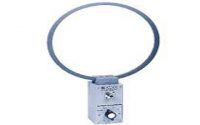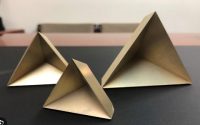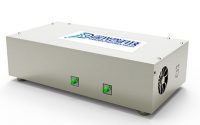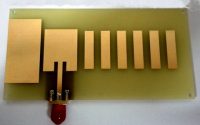Reflector Antenna : Working, Types & Its Applications
Antennas with High-gain are necessary for long-distance radio communications, radio astronomy, high-resolution radars, etc. So, the most frequently used high-gain antennas are Reflector antennas because they can easily attain above 30 dB gains for higher & microwave frequencies. So designing reflectors for many applications can result in spectacular progress in the sophisticated analytical & experimental techniques development by shaping the reflector surfaces & illumination optimization over their apertures to increase the gain. So this article discusses an overview of a reflector antenna – working with applications.
What is Reflector Antenna?
The reflector antenna definition is; an antenna that is designed for reflecting the incident electromagnetic signals originating from a separate source. This antenna is mainly designed to function at high microwave frequencies. It is most popular within spacecraft antenna systems due to its lightweight & simple structure. This antenna is made with various reflectors whose surface is hyperbolic, parabolic, spheroid, or ellipsoid. So, the parabolic is the most frequently used antenna. The reflector antenna diagram is shown below.
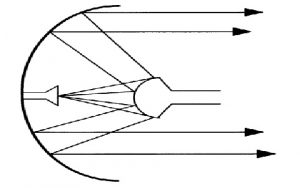
How Does a Reflector Antenna Work?
The operating principle of a reflector antenna is; this antenna works at a high range of microwave frequencies. The electromagnetic wave at this frequency performs as a light wave so, this light wave gets reflected once strikes a surface. However, this antenna is a combination of a reflecting surface & feed element which means, a reflecting surface with an antenna element is required is used to give excitation to the reflecting element. So it is composed of both an active & a passive element.
The antenna used to provide excitation is called the active element whereas the one that again radiates the emitted energy through the active element is known as the passive element or the reflecting surface. So, the active element is the feed whereas the passive element is the reflector.
Generally, this antenna plays an essential role in radio wave propagation because it changes the radiating element’s radiation pattern. These antennas operate in such a way that the feed energy is directed to the reflecting surface located at a suitable position. Further on gaining the energy, the reflector guides it in an exact direction.
Here, it is to be noted that antennas with high gain operate at microwave frequencies and have a small physical size that provides the preferred directivity. Despite providing several geometrical configurations, there are some popular forms where the antenna’s reflecting surface is formed. So based on this, further, the reflector antennas are classified.
Reflector Antenna Types
Reflector antennas are classified into different types like rod, plane, corner, cylindrical, spherical, and parabolic, and each type is discussed below.
Plane Reflector
The plane reflector antenna includes a primary antenna & reflecting surface which is very useful to emit electromagnetic energy in the preferred direction however is not feasible to collimate energy within the forward direction. This reflector is also known as a flat sheet reflector & it is considered one of the simple reflectors that direct the EM wave in the suitable direction.
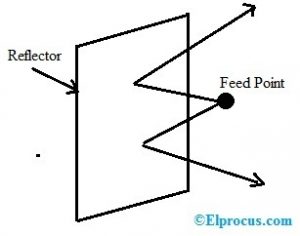
In this antenna, the plane metallic sheet is arranged at a particular distance from the feed point. For the inward radio waves, it performs as a plane mirror & permits them to experience reflection throughout it. A plane reflector possesses difficulty in collimating the overall energy within the forward direction. So, to handle the pattern characteristics, impedance, directivity & gain of the system, the active element’s polarization with its position about the reflecting face is used.
Corner Reflector
The corner reflector antenna includes a minimum of two or three conducting flat surfaces which are intersecting mutually. So in this type of antenna, the feed element is either a dipole or a collection of collinear dipoles. The corner reflector type antenna is mainly used to attain collimation of electromagnetic energy within the forward direction. So it is used to suppress radiation in the side & backward directions.
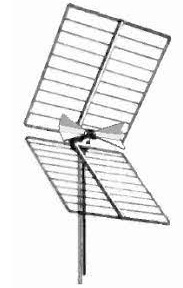
This reflector is a modified version of the plane reflector to show maximum radiation in the forward direction. Mostly, the plane reflector shape is modified by combining two level sheets to form a corner. These are used to improve the directing capacity of EM energy in the forward direction to decrease the gain of the back-reflected wave.
Cylindrical Reflector
The antenna reflector which is created with a cylindrical shape is known as a cylindrical reflector. The reflector’s cylindrical shape simply allows you to focus the signal on the surface of the antenna. These reflectors are broadly used wherever wide-angle vertical coverage & sharp azimuthal beams are necessary like line sources & airborne navigational antennas.
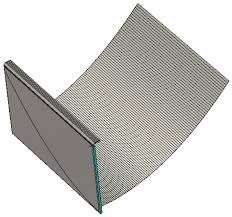
Spherical Reflector
A spherical reflector is designed with a spherical surface similar to a cylindrical reflector which means these reflectors are elements of spherical surfaces. The size of the reflector in this antenna is one-half of the spheres. These are mainly used for collimating the energy from the active elements toward the forward direction.
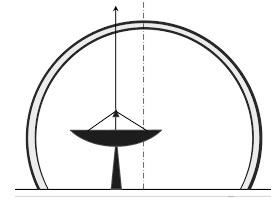
Parabolic Reflector
A type of reflector antenna that is designed in a paraboloid structure by using the parabola properties is known as a parabolic reflector. In this antenna, the active element is present which focuses the main axis to reflect the radiated wave in a parallel direction to the main axis.
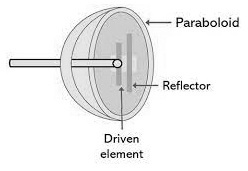
As shown in the above diagram, the waves produced by the horn antenna are incident over the reflector. This reflector simply reflects them to form a plane wavefront. These waves are canceled in other directions because of path & phase differences. So in this way, the parabolic reflector antenna changes from spherical to plane wave.
Rod Reflector
A kind of antenna that has the rod shape reflector is known as a rod reflector antenna. A rod-type reflector is mainly utilized in a Yagi-Uda antenna. This reflector is arranged at a particular distance in the back of the driven element within the antenna & generally, it has a length above the driven element length that is a half-wave dipole. The reflector in the antenna simply provides inductive reactance thus guiding the radiated field in the backward direction to the driven element to decrease the losses because of the back-reflected wave. So it helps in improving the gain.
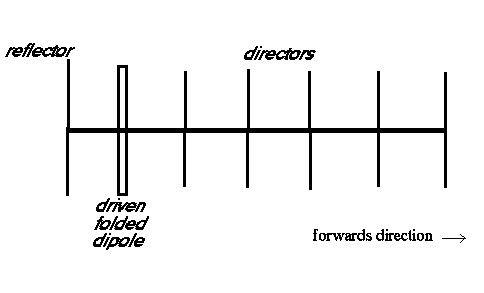
Advantages
The advantages of reflector antenna include the following.
- These are versatile.
- They have outstanding radiation performances.
- The parabolic type antenna has high gain and high directivity.
- The parabolic reflector decreases minor lobes.
- The amount of wastage of power is fairly low as compared to other antennas.
- It provides flexibility while arranging the feed element.
- The parabolic reflector provides easy beam adjustment.
Disadvantages
The disadvantages of reflector antennae include the following.
- The reflector antenna needs to be balanced to keep away from obstruction of the feed point.
- The parabolic type antenna design is a complex procedure.
- The surface distortions in parabolic reflector antenna can take place in an extremely large dish. So this can be decreased with a broad mesh in place of a continuous surface.
- This antenna size is quite large and the overall cost is also high.
- To achieve the best performance results, the feed should be placed exactly at the focus of the parabolic antenna. This is difficult to achieve practically.
Applications
The applications of reflector antennae include the following.
- A reflector antenna has been extensively used in satellite communications, radars, deep-space telemetry, radio astronomy & remote sensing.
- A reflector type is an essential part of communication as well as radar systems.
- These antennas are extensively used in point-to-point communication, remote sensing, satellite communication, deep-space telemetry, and TV signal broadcasting.
- Reflector types are applicable in radio astronomy, weather radar & in spacecraft systems.
- The performance of the antenna can be enhanced with reflectors. So reflector antenna is used to enhance directivity.
- This antenna is utilized within spacecraft applications.
Thus, this is an overview of reflector antenna – working with applications. These antennas are known as microwave antennas and the range of operating frequency offered by this antenna is usually above 1 MHz so, these antennas are used in wireless applications. Here is a question for you, what is the function of an antenna?

